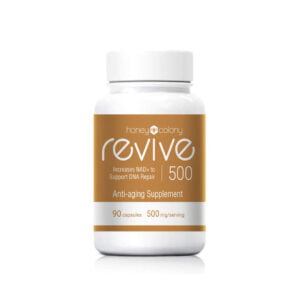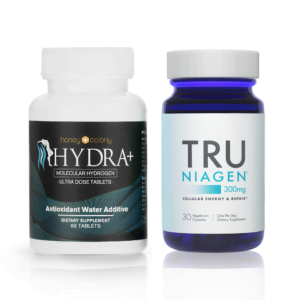One of the hottest topics in anti-aging, or life extension, circles today is the optimization of nicotinamide adenine dinucleotide (NAD+). Early research shows that this could play a role in longevity promotion, through mechanisms such as increasing cellular energy production. A NAD+ deficiency can also be genetic, and low levels during pregnancy may increase birth defects too. As levels of NAD+ decline with age, the question is, does NAD+ supplementation have any effects against aging? If so, which form is best?
What Is NAD+?
NAD+ was first discovered thanks to beer breweries. In 1906, an at-the-time mysterious “co-ferment” extracted from brewing yeast was found to speed the conversion of sugar to alcohol. It turned out to be NAD+, which can be made from niacin (vitamin B3); the amino acid tryptophan; or salvaged from niacinamide or nicotinamide riboside (NR). Over the years, researchers have found three anti-aging functions of NAD+: cellular energy production, DNA repair, and the activation of longevity-promoting genes.
The role of NAD+ in energy production is to act as a coenzyme in the mitochondria, moving electrons around to recharge the molecules that carry energy around the cell. The plus sign in its abbreviation indicates a positive charge, which attracts electrons. It also allows Poly (ADP-ribose) polymerase (PARP) to work, an enzyme that plays a key role in DNA repair. Less NAD+ and more DNA damage increases PARP to compensate, but this can further deplete NAD+ if nothing is done to replace it. What’s more, NAD+ is needed to activate the sirtuins, “longevity genes” we need for cellular repair and a healthy stress response.
Is Intravenous NAD+ The Best Anti-Aging Solution?
You’d think that directly injecting NAD+ into the bloodstream would be the best solution, as it bypasses the limits of digestion and absorption. This is also the most expensive option, at up to $600 for a session with effects that last up to six or eight weeks. However, NAD+ must be broken down into precursors to enter cells. Niacin, niacinamide and NR can be taken up by human cells, but not NAD or nicotinamide mononucleotide (NMN).
What About NMN?
NMN is thought to be more effective than NAD+, as it is one of its precursors. Laboratory research demonstrates anti-aging effects against damage in the brain, muscles, kidneys, liver, fat tissue, pancreas and retina. NMN is rapidly absorbed into the bloodstream too. A small study on ten men testing short-term NMN supplementation found that it was safe, but did not measure tissue NAD+. There are, however, 13 ongoing studies listed on Clinical Trials
Nicotinamide Riboside May Be Your Best Option
Nicotinamide riboside (NR) can be absorbed into our cells without being broken into precursors, unlike NMN or NAD+. The US Food and Drug Administration (FDA), Health Canada, the European Commission, and Australia’s Therapeutic Goods Administration (TGA) all accept the Niagen formulation as a NAD+ booster.
Preclinical research on human cell lines and C. elegans worms (a common model of aging) have found that NR supplementation increases NAD+. This has beneficial effects on two underlying mechanisms of aging: loss of proteostasis and declining mitochondrial function. Proteostasis means healthy protein production and turnover. An example of its loss is the accumulation of amyloid proteins in Alzheimer’s disease. However, this time researchers looked at amyloid buildup in the muscle tissue, so it may also impair muscle function as we get older if left alone.
NR Clinical Trials
Improved Performance
One clinical study tested the effects of short-term NR supplementation in younger and older volunteers. Younger participants had an average age of 22, while older volunteers were 71 on average. NR increased glutathione status in the older group, and superoxide dismutase (SOD) in the younger volunteers, which are two key antioxidant enzymes. Only the older participants saw improved exercise performance, in the areas of isometric peak torque and resistance to fatigue. In fact, their Fatigue Index scores fell to the level of the younger group! They also saw non-significant improvements in VO2 max, an indicator of aerobic fitness, and concentric peak torque. This is in line with animal studies that show stronger benefits in cases of metabolic stress.
Weight Management
Another study involved overweight and obese men and women, assigned to either 1000mg/day of NR or a placebo for six weeks. Supplementation with NR increased fat-free body mass, from 61.32 percent to 62.65 percent. Women were more likely to show this effect than men. It also boosted acetylcarnitine levels in muscle tissue by roughly 33 percent, which we need for energy production. This is linked to improved metabolic health and increased metabolic flexibility.
Choose Niagen for NAD+
Tru Niagen, a crystal form of NR chloride, has been demonstrated to significantly increase NAD+ levels in the body within two weeks. Overall, the available research points to NR as a safe and effective way to boost NAD+, with benefits in exercise performance, energy levels and body composition emerging in clinical trials. If you’re looking for a convenient anti-aging intervention, the Tru Niagen form of NR may be just what you need.

Alexandra Preston is an Australian naturopath, passionate about empowering others to take charge of their health and healing the planet. Her special area of interest in natural health is antiaging; she also loves the beach and is a semi-professional dancer.
Submit your story or essay to Buzzworthy Blogs.
-
Sale Product on sale
 Tru Niagen NAD Supplement$54.00 – $144.00 — or subscribe and save 5%Rated 4.83 out of 5 based on 6 customer ratings
Tru Niagen NAD Supplement$54.00 – $144.00 — or subscribe and save 5%Rated 4.83 out of 5 based on 6 customer ratings -
Sale Product on sale
 NMN Revive: Anti-Aging + DNA Repair
NMN Revive: Anti-Aging + DNA Repair$90.99Original price was: $90.99.$75.00Current price is: $75.00. -
Sale Product on sale
 Optimized Cellular Health Bundle
Optimized Cellular Health Bundle$113.74Original price was: $113.74.$106.74Current price is: $106.74. — available on subscription from$112.99Original price was: $112.99.$100.00Current price is: $100.00. / monthRated 5.00 out of 5 based on 3 customer ratings



